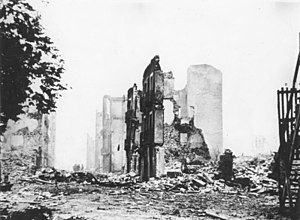
Back Bombardeyo de Guernica AN قصف غرنيكا Arabic Bombardéu de Gernika AST Бамбардзіроўка Гернікі Byelorussian Бамбаваньне Гернікі BE-X-OLD Бомбардировка на Герника Bulgarian Bombezadeg Gernika Breton Bombardeig de Guernica Catalan Bombardování Guerniky Czech Luftangriff auf Guernica German
| Operation Rügen | |
|---|---|
| Part of the Spanish Civil War | |
 Ruins of Guernica (1937) | |
| Type | Aerial bombing |
| Location | Guernica, Basque Country, Spain 43°18′50″N 2°40′42″W / 43.31389°N 2.67833°W |
| Planned by | National Defense Junta |
| Date | 26 April 1937 16:30 – 19:30 (CET) |
| Executed by | |
| Casualties | ~150–1,654 (estimates vary) killed |
Location of Guernica within the Basque Autonomous Community | |
On 26 April 1937, the Basque town of Guernica (Gernika in Basque) was aerial bombed during the Spanish Civil War. It was carried out at the behest of Francisco Franco's rebel Nationalist faction by its allies, the Nazi German Luftwaffe's Condor Legion and the Fascist Italian Aviazione Legionaria, under the code name Operation Rügen. The town was being used as a communications centre by Republican forces just behind the front line, and the raid was intended to destroy bridges and roads.[1] The operation opened the way to Franco's capture of Bilbao and his victory in northern Spain.
The attack gained controversy because it involved the bombing of civilians by a military air force. Seen as a war crime by some historians, and argued as a legitimate attack by others,[2] it was one of the first aerial bombings to capture global attention. Under the international laws regarding aerial warfare in 1937, Guernica was a legitimate military target.[3] The number of victims is still disputed; the Basque government reported 1,654 people killed at the time, while local historians identified 126 victims[4] (later revised by the authors of the study to 153).[5] A British source used by the USAF Air War College claims 400 civilians died.[6][7] Soviet archives claim 800 deaths on 1 May 1937, but this number may not include victims who later died of their injuries in hospitals or whose bodies were discovered buried in the rubble.[8]
The bombing is the subject of the anti-war painting Guernica by Pablo Picasso, which was commissioned by the Spanish Republic. It was also depicted in a woodcut by the German artist Heinz Kiwitz,[9] who was later killed fighting in the International Brigades,[10] and by René Magritte in the painting Le Drapeau Noir.[11] The bombing shocked and inspired many other artists, including a sculpture by René Iché, one of the first electroacoustic music pieces by Patrick Ascione, musical compositions by Octavio Vazquez (Gernika Piano Trio), René-Louis Baron and Mike Batt (performed by Katie Melua), and poems by Paul Eluard (Victory of Guernica), and Uys Krige (Nag van die Fascistiese Bomwerpers, English translation from the Afrikaans: Night of the Fascist Bombers). There is also a short film from 1950 by Alain Resnais titled Guernica.
- ^ Cite error: The named reference
:6was invoked but never defined (see the help page). - ^ Corum 1997, pp. 198–199.
- ^ Corum 2008, p. 134.
- ^ "Verdades sobre Gernika" [Truths about Gernika]. Deia (in Spanish). 27 April 2011. Archived from the original on 23 July 2012. Retrieved 17 September 2013.
- ^ Sillero Alfaro, Maider. "Los gernikarras hemos recibido desde niños por transmisión oral lo que fue el bombardeo" [We Gernikarras have received from childhood what the bombing was like through oral transmission]. Euskonews (in Spanish). Retrieved 17 September 2013.
- ^ Corum, James (1 April 1998). "INFLATED BY AIR: COMMON PERCEPTIONS OF CIVILIAN CASUALTIES FROM BOMBING" (PDF). Air War College. Retrieved 5 April 2024.
- ^ "The legacy of Guernica". BBC. 26 April 2007. Retrieved 17 September 2013.
- ^ Abrosov, Sergei (2008). Vozdushnaya voyna v Ispanii: khronika vozdushnykh srazheniy 1936-1939 gg [The air war in Spain: a chronicle of air battles 1936-1939] (in Russian). Moscow: Yauza. ISBN 978-5-699-25288-6.
- ^ Gnichwitz, Siegfried. "Heinz Kiwitz: gekämpft · vertrieben · verschollen" [Heinz Kiwitz: fought · expelled · missing] (PDF). Stiftung Brennender Dornbusch (in German). Archived from the original (PDF) on 20 November 2012. Retrieved 10 February 2012.
- ^ Becker, Thomas (1 June 2013). "Willkommen im Club der Millionäre" [Welcome to the millionaires club]. Der Westen (in German). Archived from the original on 26 September 2023. Retrieved 3 April 2024.
- ^ "Le Drapeau noir [The Black Flag]". National Galleries of Scotland. Retrieved 3 April 2024.
© MMXXIII Rich X Search. We shall prevail. All rights reserved. Rich X Search
